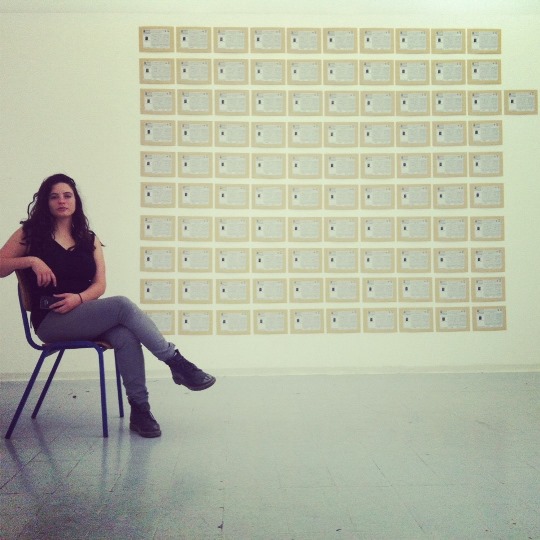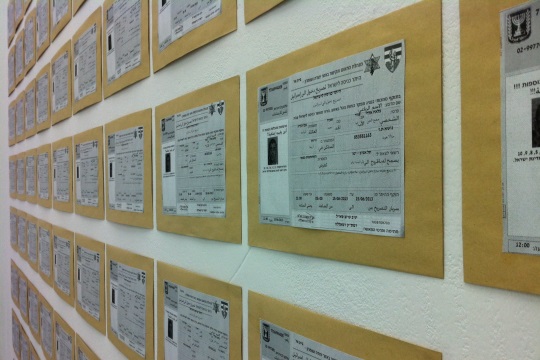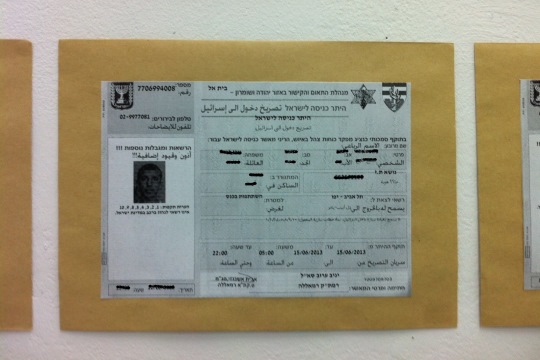May Castelnuovo presents a visual representation of 101 things, at which we would rather not look.
As the crow flies, the Bezalel Academy of Art and Design is situated less than one kilometer from the separation wall. Indeed, the crow need not even fly from Israel’s most prestigious art school to the questionable concrete barrier; it can mosey there at ease.
Within Bezalel, one finds the typical Israeli mix of art that concerns itself with local realities and that which stubbornly ignores them. This post is dedicated to one work of the first category, presented only last week by a student at Bezalel’s photography department. I am sharing it for two reasons. First, it is the work of a dear friend, who is also a recent creative partner and +972 contributor. May Castelnuovo is responsible for the photography and film footage of “Last Metro to Taksim,” a five part exploration of protest-Istanbul.
Second, while professedly a rudimentary experiment, it is an enormously educational piece of art. It is made up of permits – permits necessary for movement, permits for crossing the wall. The crow may fly right over it, but it traps men and women. Many Palestinians never get a permit to cross the separation barrier and go into Israel. For those who do, Israel issues 101 kinds of permits: only for Jerusalem, only for a specific hospital in Jerusalem, only for daylight hours, for all hours, for a few hours, etc., etc.
The permit policy can be described as a form of bureaucratic violence, or at least a tool of intimidation. Palestinians receive no information about how to qualify for a permit. One permit expires, and the next offers entirely different liberties, for no apparent reason. The printers at Kafka’s castle work overtime.
Like the wall itself, the policy is presented as a security measure. It is, however, a dubious one. On one fine day last August, Israel experimented with relaxing this policy and lavishly issued nearly 300,000 permits, drawing multitudes of Palestinians to Mediterranean beaches. No violent incidents were recorded that day. The meager value of this gross infringement on human rights was clearly displayed, and yet the experiment has not yet been repeated.
Castelnuovo sought to obtain copies of all the different types of permits and post them as is on one of Bezalel’s walls. She learned that this is pretty much impossible, even for an Israeli. The permits are issued at the whim of the “Civil Administration,” a incommunicable, totalitarian arm of Israel that manages the lives of 2.5 million Palestinians in the West Bank. The Civil Administration’s headquarters are located in the settlement of Beit El, near Ramallah. It is an organization of which most Israelis know nothing at all. Few express curiosity about it.
So here’s one who did express some curiosity, and found herself running up against a wall. Even Gisha, an NGO that concerns itself directly with the freedom of movement of Palestinians, was unable to supply all 101 variations. Castelnuovo obtained a single permit. It permits its holder only to visit Tel Aviv, for one day only, in order to attend a conference. She photocopied it 101 times, and posted the copies in a form that highlights their prime number (the deletions on the photo are my own, made at the suggestion of the artist).
The piece poses a couple of interesting questions from an artistic standpoint. Here is a photographer making use of the Xerox lens, for want of an effective photographic vantage point on her subject matter. Here is also a very charged use of a replication: does the multiplying of the single permit reduce it to a Campbell’s soup can? Is this work not only repetitive, but redundant?
I think not. Rarely does one encounter a more honest artistic rendering of our homegrown evils. In Maya Angelou’s poem “I know why the caged bird sings”, the caged bird sings of its shattered dreams, while the free bird is oblivious to such sufferings. At Bezalel last week, a free bird lamented the condition of the caged ones, and her song was a concise and precise chirp. With society, the media and the education system looking the other way, this is the most we may know – a single story, and even that, only if we care to listen. Then we must use our imagination to sense the unthinkable reality. Our neighbors, by the millions, are subjected to endless, constant, meticulously designed harassment in our name.




